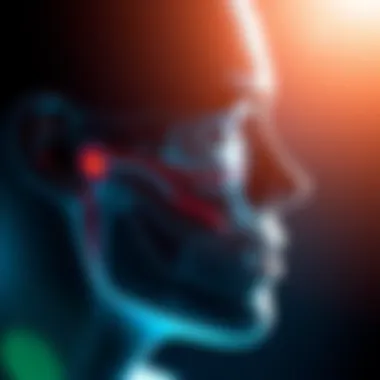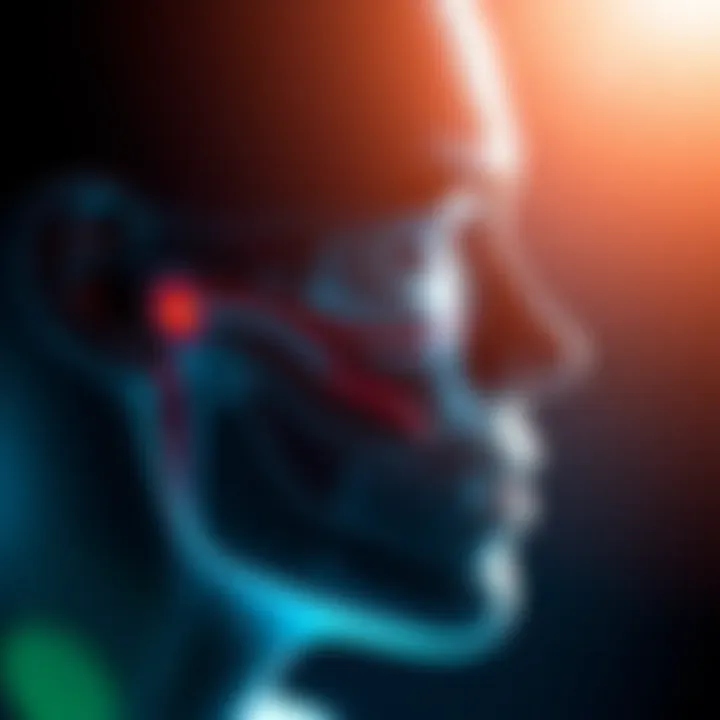Effective Strategies for Managing Sinus Headaches


Intro
Sinus headaches can feel like an uninvited guest that just won’t leave. They can leave you feeling like your head is stuck in a vice grip, often accompanied by a throbbing pain around your forehead, cheeks, and sometimes even your teeth. Understanding these headaches starts with a grasp on how the sinuses work and what triggers these painful episodes.
When your sinuses become inflamed or blocked, pressure builds up—and that’s when the headaches begin. Whether it’s due to allergies, a cold, or changes in weather, the factors can be numerous. So, let's dive into the world of sinus headaches and explore the causes, symptoms, and strategies to relieve this discomfort.
Understanding Sinus Headaches
What are Sinus Headaches?
Sinus headaches are closely linked to sinusitis, a condition where the sinuses become inflamed. Unlike a typical headache, the pain from sinus headaches can be more localized, often resulting in discomfort that feels heavy and persistent.
Some indicators that you’re dealing with a sinus headache include:
- Throbbing or aching pain: This common characteristic can make it hard to focus on anything else.
- Facial pressure: You may feel like there’s a weight resting on your forehead, cheeks, or behind your eyes.
- Congestion and nasal discharge: Sinus headaches often show up with other nasal symptoms like postnasal drip or a runny nose.
Recognizing these symptoms early can help you manage them more effectively.
Common Triggers of Sinus Headaches
Sinus headaches can be triggered by a variety of factors, including:
- Allergies: Pollen, dust, and pet dander can all lead to inflammation in the sinuses.
- Infections: Colds and bacterial infections are prime suspects in causing sinus headaches.
- Environmental Factors: Sudden changes in weather or exposure to pollutants can also kick off symptoms.
Knowing your triggers is crucial in preventing sinus headaches from taking hold.
Strategies for Alleviating Sinus Headaches
There are several ways to manage these headaches, ranging from at-home remedies to when to seek professional help. Let’s explore some practical options:
Home Remedies
- Steam Inhalation: Breathing in steam can help to open up your sinuses and relieve pressure.
- Warm Compresses: Applying a warm towel to the face can soothe areas of pain and enhance blood flow.
- Hydration: Keeping hydrated helps thin mucus, making it easier for your sinuses to drain.
Over-the-Counter Medications
Over-the-counter options like ibuprofen or acetaminophen can help manage pain. Decongestants, such as pseudoephedrine, can also provide temporary relief by reducing nasal congestion. However, it’s important to follow dosage recommendations to avoid side effects.
Lifestyle Adjustments
Making some lifestyle changes can have a remarkable impact on reducing sinus headaches:
- Regular Exercise: Physical activity can help reduce inflammation and improve general health.
- Good Sleep Hygiene: Ensuring that you get adequate sleep can help your body better manage stress and inflammation.
- Avoiding Known Triggers: Whether it's allergens or particular foods, staying away from what triggers your symptoms can help.
When to Seek Professional Help
If you find that sinus headaches are persistent and are not alleviated by the methods mentioned, it may be time to consult a healthcare professional. Indicators may include prolonged symptoms lasting over a week, severe pain, fever, or vision changes.
It's always better to err on the side of caution and get a professional opinion when your health is in question.
Epilogue
Sinus headaches are not just an inconvenience; they can impact your day-to-day life. By understanding the causes, recognizing the symptoms, and employing a range of strategies for relief, you can better manage your pain. With a mix of home remedies, over-the-counter treatments, and lifestyle adjustments, individuals can pave the way towards less discomfort and improved well-being.
Remember, awareness of your own body and what works best for you is key in tackling sinus headaches and reclaiming your life from their clutches.
Prologue to Sinus Headaches
Sinus headaches are a common yet often misunderstood ailment, causing discomfort that extends beyond mere pain. Understanding what they entail forms the foundation of effective management strategies that can truly alleviate the suffering that many experience. As we explore this topic, it becomes evident that pinning down the definition, causes, and appropriate interventions is key for those grappling with recurring attacks.
Often perceived merely as a nuisance, sinus headaches can disrupt daily life, impacting both productivity and overall quality of life. However, by demystifying these headaches, individuals can gain insights into their patterns and triggers, allowing for more informed choices regarding relief methods. This section will shed light on nuanced aspects, notably how sinus headaches present themselves, and the common culprits behind them.
Defining Sinus Headaches
Sinus headaches emerge from the inflammation of the sinus cavities, primarily due to blocked sinus drainage or an overactive immune response. This discomfort typically radiates around the forehead, eyes, and cheeks. They often occur in conjunction with sinusitis, where the sinus linings become inflamed, crimping breathable air and liquid exit.
Common Causes of Sinus Headaches
Several factors contribute to the onset of sinus headaches. A reliable understanding of these causes aids one's ability to pinpoint triggers and find relief.
Allergies
Allergies are one of the most prevalent reasons people experience sinus headaches. When allergens enter the nasal passages, they can evoke a response from the immune system, leading to inflammation. Swelling in the sinus cavities resulting from allergies can create a breeding ground for pain. A unique aspect of allergies is that they are often seasonal but can linger year-round depending on specific sensitivities.


The downside here is the struggle with recurrent symptoms, which can lead to frustration for many. Recognizing these trigger points is beneficial for devising a personal management plan. Armed with targeted strategies, individuals can potentially stave off attacks caused by their allergic responses.
Sinus Infections
Sinus infections contribute significantly to the headache equation. When bacteria or viruses infiltrate the sinus cavities, they can provoke inflammation and pressure, leading to headaches that can feel like a ton of bricks on the forehead. What distinguishes sinus infections from other types of headaches is the odor and color of nasal discharge, which often hints at the severity of the condition.
This infection may require medical intervention, particularly if symptoms persist. Thus, understanding when a simple headache morphs into a more intricate invitation for treatment is crucial.
Environmental Factors
Environmental factors play a subtle yet crucial role in triggering sinus headaches. Changes in the weather, pollution levels, and use of artificial fragrances can lead to irritation of the sinus passages. Unique features of environmental factors rest in their variability; for instance, a cold front can cool down humid air, causing thick mucus – enough to cross contours into headache territory.
Such triggers often necessitate a proactive approach to environmental management. Simple adjustments, like using air purifiers or monitoring local allergen reports, can significantly reduce their grip.
Understanding the myriad causes of sinus headaches not only fosters greater awareness but empowers individuals to take charge of their health. In this ongoing exploration, recognizing these catalysts allows for a more strategic approach towards alleviating discomfort. By fabricating personalized relief plans, each person can navigate through their own sinus-induced challenges.
Recognizing Symptoms of Sinus Headaches
Recognizing the symptoms of sinus headaches is essential for effective management and relief. Without understanding the particular signs your body gives you, it becomes quite daunting to navigate treatment options. Different people may express symptoms differently, thus, it’s crucial to have a keen eye on the nuances of what a sinus headache feels like compared to other forms. Knowing these symptoms can help you seek suitable remedies and take preemptive actions before pain becomes unbearable.
Identifying Key Symptoms
Facial Pain and Pressure
Facial pain and pressure often define the hallmark of a sinus headache. You're likely to feel discomfort in your cheeks, forehead, and around the eyes. This sensation usually heightens when you have a cold or experience changes in weather. The key characteristic is the dull yet persistent ache that can sometimes become sharp in intensity. This aspect not only guides you in recognizing a sinus headache but also helps you discern the underlying cause—whether it's allergies, a sinus infection, or another trigger.
In recognizing this symptom, it's beneficial as it correlates with a potential buildup of mucus in the sinus cavities, which, if left unchecked, can escalate into a more severe condition. However, sometimes the pain may be misleading, mimicking the sensation of dental issues, which could lead to confusion.
Nasal Congestion and Discharge
Another crucial symptom is nasal congestion and discharge. Often, when faced with a sinus headache, you may notice your nostrils feeling blocked, almost as if they are stuffed with cotton. This symptom directly ties into the sinus cavities’ inflammation leading to fluid buildup. The key characteristic here is thick, often discolored mucus, which can indicate an underlying infection.
Understanding this symptom can be beneficial as it helps in determining if you require additional medical attention, like antibiotics. Yet, it can also be a double-edged sword; the sinus pressure might mask the congestion, making it slightly tricky for someone to identify that they are dealing with a sinus-related issue.
Headache Location and Intensity
When considering headache location and intensity, it’s important to know where pain is concentrated. In sinus headaches, discomfort typically stems from the forehead, cheeks, and the bridge of the nose. The sensation may feel like a throbbing or pounding pressure. Having accurate knowledge of this symptom is beneficial as it allows you to convey your experience effectively to healthcare professionals. Whether the pain worsens when bending over or is affected by sudden movements can significantly alter treatment paths.
Recognizing this unique feature of headache location can help individuals avoid potential confusion with migraine-like symptoms which might be more localized to one side or may pulse intensely. However, the overlap between sinus headaches and migraine symptoms can lead to misdiagnosis, underscoring the importance of keeping a symptom diary.
Differentiating from Other Types of Headaches
Comparison with Migraines
When contrasting sinus headaches with migraines, one must consider the intensity and characteristic nature of the pain. Migraines often come with added symptoms such as light sensitivity and nausea, which are less common in sinus headaches. The key distinguishing factor is that sinus-related headaches are typically accompanied by facial pressure and nasal congestion.
This comparison is crucial for avoiding unnecessary treatments. Migraines may require preventive medications and lifestyle changes that wouldn’t be as beneficial for those suffering specifically from sinus headaches. Although sometimes people can experience both, hence understanding the difference is pivotal for effective management.
Distinguishing Tension Headaches
Distinguishing tension headaches from sinus headaches can also be a tricky affair. Tension headaches often feel like a tight band around your head, with minimal facial pain. Understanding this key feature can empower someone dealing with persistent headaches by recognizing what's likely a muscle-related ache versus a sinus-related issue.
The underlying tension is often related to stress and may be relieved by relaxation techniques and over-the-counter painkillers. This differentiating factor illustrates that while both types of headaches can be debilitating, their common causes and treatments differ widely.
Home Remedies for Sinus Headache Relief
Finding relief from sinus headaches often begins at home, where simple yet effective remedies can mitigate discomfort. These methods hold particular significance for those seeking non-pharmaceutical options. Engaging in home remedies not only provides immediate relief, but also fosters a sense of empowerment and control over one’s health. After all, if you can treat your symptoms without needing a prescription, that’s a win in anyone’s book. This section will delve into practical techniques that can be easily implemented, spotlighting their benefits and considerations.
Steam Inhalation Techniques
Steam inhalation is an age-old remedy that often turns the tide against sinus headaches. The process is relatively straightforward and can typically be done at home with just hot water and a towel. The steam generated helps to loosen mucus in the sinuses, alleviating pressure and promoting drainage.
- How to Execute the Technique:
- Benefits of Steam Inhalation:
- Fill a bowl with hot water—be cautious not to boil it excessively to avoid burns.
- Optionally, few drops of essential oils like eucalyptus can enhance benefits, aiding in opening the nasal passages.
- Lean over the bowl, covering your head and the bowl with a towel to trap the steam. Breathe deeply for about 10-15 minutes.
- It hydrates the mucous membranes, making them less likely to swell.
- Provides immediate relief, reducing headache intensity in many cases.
- It’s suitable for various age groups, promoting accessibility.
While steam inhalation can be powerful, it’s best suited as a complementary technique alongside other treatments, especially for severe headaches.
Saline Nasal Irrigation
Saline nasal irrigation often flies under the radar, yet it can be a game changer for sinus health. This method involves flushing the nasal passages with a saltwater solution, helping clear out mucus and allergens that can cause headaches.


- Getting Started:
- Procedure:
- Why It Helps:
- You can use a neti pot or a squeeze bottle designed for nasal rinsing.
- Mix a saline solution—typically, one teaspoon of salt dissolved in 8 ounces of distilled or boiled water works wonders.
- Position yourself over a sink, tilting your head to one side.
- Insert the spout of the neti pot into the upper nostril and allow the saline to flow through, clearing out the lower nostril.
- Repeat on the other side.
- Clears nasal passages, reducing sinus pressure and headache triggers.
- Helps prevent sinus infections by removing pathogens.
- Cost-effective with minimal risks when performed correctly.
As beneficial as saline irrigation can be, one must stay disciplined with cleanliness, using sterile equipment to prevent infections.
Applying Warm Compresses
Warm compresses represent another straightforward yet often underappreciated remedy for sinus headaches. The application of warmth to the sinus area can relax muscles and open up the sinus passages, paving the way for relief.
- Simple Application:
- Benefits:
- Soak a clean cloth in warm water (not scalding hot) and wring it out.
- Fold the cloth and place it over your forehead and nose, focusing on the sinus areas.
- Keeping it on for 10-20 minutes can induce relaxation and relieve pain.
- Eases the throbbing sensation typical in sinus headaches.
- Enhances blood circulation in the affected areas, which can speed up recovery.
- Non-invasive and can be repeated multiple times a day when needed.
While warmth can be soothing, it’s worth remembering that if headaches persist or worsen, seeking additional treatment may be necessary. These remedies, while effective for many, may not suffice in every instance.
"A little self-care goes a long way."
Utilizing these home remedies is just one way to tackle the discomfort of sinus headaches head-on. They offer a blend of immediate relief and encourage a proactive approach to managing sinus health. By incorporating these techniques into your repertoire, you may find a sustainable, comforting path toward reducing sinus-related distress.
Over-the-Counter Medications for Relief
When it comes to alleviating the discomfort caused by sinus headaches, over-the-counter medications are often the first line of defense. They offer quick and accessible options for relief, empowering individuals to tackle their symptoms without the need for prescriptions.
These medications can work wonders in reducing inflammation, easing pain, and helping to clear nasal congestion. The effectiveness of these drugs can vary based on the individual, but understanding their roles can significantly enhance one’s approach to managing sinus headaches.
Nonsteroidal Anti-Inflammatory Drugs (NSAIDs)
Advil
Advil, which contains ibuprofen, is widely known for its pain-relieving properties. This NSAID works by blocking the production of substances in the body that trigger inflammation and pain. For those suffering from sinus headaches, Advil's key characteristic is its potent anti-inflammatory effect, making it a popular choice among individuals seeking quick relief.
One unique feature of Advil is its comparatively faster action in alleviating pain than some other medications. This speed can be an advantage, especially when one needs prompt relief to go about daily activities. However, a consideration to keep in mind is that prolonged use may lead to stomach irritation or ulcers in some people, so it’s wise to follow the recommended dosages.
Aspirin
Aspirin is another well-known NSAID that plays a crucial role in managing pain and inflammation. Much like Advil, it works by inhibiting certain chemicals in the body that cause inflammation. The key aspect of Aspirin is its effectiveness not just as a pain reliever but also as a fever reducer, which can be beneficial in some sinus headache cases that accompany sinus infections.
A notable distinctive feature of Aspirin is its blood-thinning properties, which can aid in preventing blood clot formation. Nonetheless, this characteristic also leads to considerations regarding its use. Those with certain health conditions such as bleeding disorders or those taking anticoagulant medications should be cautious. Additionally, Aspirin might not be suitable for children or teenagers due to the risk of Reye's syndrome, a rare but serious illness.
Decongestants
Decongestants can also be incredibly beneficial for individuals grappling with sinus headaches. These medications work by narrowing blood vessels in the nasal passages, helping to decrease swelling and congestion. This swelling is often a major contributor to the pressure and pain associated with sinus headaches.
There are two main types of decongestants: oral and nasal. Oral decongestants, such as pseudoephedrine, provide longer-lasting relief but may cause insomnia or increased heart rate. Meanwhile, nasal decongestants can work very quickly but should be used with caution, as overuse can lead to rebound congestion.
Antihistamines
Antihistamines are often a key player in alleviating symptoms related to allergies that can trigger sinus headaches. These medications work by blocking histamine, a substance released during an allergic response. By doing so, they can help reduce allergy-related nasal congestion and inflammation.
Some antihistamines, such as diphenhydramine, may cause drowsiness, making them better suited for nighttime use. On the other hand, newer non-drowsy options like loratadine are great for day use, allowing individuals to function normally while still managing their allergy symptoms.
In summary, over-the-counter medications play a crucial role in alleviating the discomfort caused by sinus headaches. Whether through nonsteroidal anti-inflammatory drugs like Advil and Aspirin, decongestants, or antihistamines, having the right knowledge can lead to effective symptom management. For those wishing to delve deeper, resources such as Wikipedia and CDC can offer more comprehensive information on these medications.
Lifestyle Changes to Prevent Sinus Headaches
In dealing with the nagging discomfort of sinus headaches, proactive lifestyle changes play a crucial role. It’s not only about addressing symptoms when they strike; it's also about taking practical steps to prevent those headaches from making a come back. Embracing certain habits and adjustments can significantly reduce the risk of their occurrence and enhance overall well-being. Let's explore how small shifts in daily routines can reignite your quality of life.
Importance of Hydration
Staying hydrated is often underrated, yet it's a cornerstone of sinus health. When we talk about hydration, we're not just referring to gulping down a few glasses of water here and there. It's about consistently maintaining adequate moisture levels in your body. Dehydration can cause mucus in the sinuses to become thick, making it harder to drain effectively. This thickened mucus can lead to blocked sinuses and subsequently, headaches. By ensuring you're drinking plenty of water throughout the day—aiming for at least eight 8-ounce glasses—you can help keep your mucus thin, easing drainage and reducing the chance of sinus pressure.
Managing Allergens in Your Environment
Allergens can be sneaky culprits behind sinus headaches. Dust mites, mold, pet dander—the list goes on, and for many, a home might be a breeding ground for these irritants. One effective method for managing allergens is regular cleaning. Vacuuming often using a HEPA filter can capture microscopic particles that regular vacuums might miss. Washing bedding in hot water weekly also helps to eradicate dust mites. Furthermore, consider implementing air purifiers in commonly used spaces, particularly if you have pets or live in areas with high pollen counts. Reducing the allergen load in your environment can take a weight off your sinuses.
Implementing a Balanced Diet


Diet is ten times more essential than we often give it credit for, particularly when it’s about preventing headaches. Eating a well-rounded diet includes incorporating fresh fruits and vegetables, whole grains, healthy fats, and lean proteins. These food categories contribute nutrients crucial for your overall health and specifically support immune function, which is vital when dealing with sinus issues.
Foods that May Trigger Headaches
While some foods can nourish, others can trigger, and understanding this distinction can significantly impact sinus health. A few notable offenders often include:
- Dairy Products: For some individuals, dairy can thicken mucus production, leading to discomfort.
- Processed Foods: These often contain preservatives and additives that may provoke headaches.
- Caffeinated Beverages: While caffeine can offer temporary relief, overconsumption might lead to headaches once the effect wears off.
By keeping a food diary, individuals can pinpoint their personal triggers and craft a diet that minimizes the risk of headaches.
Nutrient-Rich Foods for Sinus Health
In contrast, certain nutrient-rich foods are champions for sinus health. Incorporating these can support your body’s natural defense against inflammation. Some key foods include:
- Citrus Fruits: High in vitamin C, they boost immunity and help clear sinuses.
- Garlic: Known for its anti-inflammatory and antimicrobial properties, garlic can fight off infections that contribute to sinus headaches.
- Leafy Greens: Packed with antioxidants and vitamins, they help bolster your body's resilience.
- Omega-3 Fatty Acids: Found in fatty fish like salmon, these are beneficial for reducing inflammation. Implementing these nutrient-rich foods not only supports sinus health, but they also contribute to overall health, making them a versatile choice for any diet.
"An ounce of prevention is worth a pound of cure."
Taking steps towards a healthier lifestyle can diminish the chances of sinus headaches and set you on a course toward thriving overall well-being. By understanding and integrating these changes into your daily life, you’re not just addressing headaches; you’re enhancing your quality of life.
When to Seek Professional Help
Sinus headaches can be a nagging source of discomfort that may disrupt daily life. While home remedies and over-the-counter medications can provide relief for many, there are important situations when professional help should be pursued. Recognizing when to turn to healthcare experts can make a significant difference in managing your symptoms effectively.
Identifying Severe Symptoms
Not all headaches are created equal. When sinus headaches escalate to severe symptoms, it becomes crucial to seek medical attention. Pay close attention to markers such as:
- Persistent pain: If your headache lingers longer than a week without improvement.
- Swelling or redness around the eyes or face that signifies serious infection.
- Fever: A high temperature may indicate an underlying infection that requires treatment.
- Vision changes: Blurred vision or any visual disturbances could be a sign of increased pressure in the head.
If you experience any of these symptoms, it’s advisable to consult a healthcare professional to properly assess your situation.
Understanding Chronic Sinusitis
Chronic sinusitis presents itself differently than typical sinus headaches. This condition lasts for more than twelve weeks and often results in prolonged discomfort. Associated symptoms include:
- Daily or frequent headaches that just won't shake off.
- Nasal obstruction that doesn’t clear up, along with a thick discharge that may vary in color.
- Loss of smell or taste, which can be frustrating and is often linked to ongoing sinus issues.
Understanding the implications of chronic sinusitis is essential, as it often requires a multifaceted approach to treatment including possible interventions or long-term medical management.
Consultations with Healthcare Professionals
ENT Specialists
ENT (Ear, Nose, and Throat) specialists play a pivotal role in diagnosing and treating sinus-related issues. These physicians provide many benefits:
- Focused Expertise: ENT specialists specialize in the anatomy and health of sinuses, making them a wise choice when sinus headaches persist or worsen.
- Advanced Diagnostics: Their training allows them to utilize imaging techniques like CT scans, which offer insights beyond standard examinations.
A unique feature of seeing an ENT is their comprehensive view which integrates both medical and surgical options, depending on what's most appropriate for the patient. However, it's essential to be aware that consultations with specialists might require a referral from a general practitioner, which can delay service.
Allergy Testing
Allergy testing represents another useful avenue in addressing sinus headaches. Allergies can exacerbate sinus problems and lead to headaches as a secondary symptom. Key characteristics of allergy testing include:
- Identification of Triggers: Knowing what specific allergens contribute to sinus and headache symptoms can strategically guide treatment options and lifestyle modifications.
- Tailored Treatment Plans: Results from allergy tests can inform both immediate and ongoing treatment strategies, like immunotherapy or specific medications.
However, there’s also a downside to keep in mind. Not all allergies are responsible for sinus issues, and insurance may not cover all tests, resulting in potential out-of-pocket expenses. Moreover, navigating through the results requires an experienced eye to effectively translate them into actionable steps.
A well-rounded understanding of these facets can empower individuals, ensuring they take the right steps when confronting debilitating sinus headaches. Always prioritize your health and don’t hesitate to reach out for professional support when needed.
Ending
In closing, understanding and managing sinus headaches is crucial for those who face this discomfort regularly. This article has offered a comprehensive examination of the issues surrounding sinus headaches, from identifying symptoms to exploring remedies and lifestyle adjustments. Recognizing the significance of sinus headaches goes beyond mere symptom management; it encourages individuals to take ownership of their health.
By summarizing key takeaways, we emphasize that awareness of personal symptoms and triggers can transform how one deals with these headaches. This knowledge leads to more tailored strategies for relief, whether it’s through home remedies or medication. 💡
Additionally, the importance of engaging with healthcare professionals is highlighted in the discussion of when to seek help. This aspect cannot be overstated, as the right guidance can prevent chronic issues and improve overall quality of life. The collaborative approach between patients and medical experts fosters a healthier, more informed community.
Moreover, the article encourages self-management strategies. Empowering oneself with knowledge serves as a powerful tool in hedging against the disruptive nature of sinus headaches.
"Knowledge is the first step towards control."
Ultimately, an informed individual is better equipped to navigate the treacherous waters of sinus headache discomfort, leading to not just relief, but enhancement in daily functioning and quality of life.
Summarizing Key Points
- Defining Sinus Headaches: Recognition of sinus headaches and their specific characteristics helps individuals distinguish them from other headache types.
- Symptoms Identification: Understanding the symptoms, such as facial pain and nasal congestion, is vital for accurate diagnosis.
- Home Remedies: Practical strategies like steam inhalation and saline irrigation have been shown to provide relief.
- Medicinal Options: Over-the-counter medications, including NSAIDs and decongestants, serve as swift solutions for symptom management.
- Lifestyle Adjustments: Hydration and allergen management play significant roles in both prevention and relief.
- Professional Help: When symptoms escalate or become chronic, consulting healthcare professionals is essential, especially ear, nose, and throat specialists and allergists.
Empowering Self-Management Strategies
Self-management is less about enduring discomfort and more about proactive steps to alleviate issues. To foster self-management, consider these strategies:
- Regular Nasal Hygiene: Incorporating saline rinses into daily routines can keep nasal passages clear, preventing buildup that leads to pain.
- Stay Informed: Keeping a headache diary could illuminate patterns or triggers related to individual headaches.
- Mindful Eating: Knowing which foods aggravate sinus conditions is critical. Avoid heavy dairy or overly processed foods that could lead to greater congestion.
- Hydrate: Drinking ample water is a simple yet powerful method to support sinus health by thinning mucus.
- Utilize Natural Remedies: Sometimes a warm compress or soothing herbal teas can work wonders and provide a welcomed comforting effect.
Building a lifestyle that prioritizes sinus health isn't an overnight task, but rather a gradual process that reaps benefits over time. By actively managing one’s health, individuals can reclaim their comfort and peace, sidestepping the burden that sinus headaches often impose.















